Electricity
| Articles about |
| Electromagnetism |
|---|
 |
Electricity is the set of physical phenomena associated with the presence and motion of matter possessing an electric charge. Electricity is related to magnetism, both being part of the phenomenon of electromagnetism, as described by Maxwell's equations. Common phenomena are related to electricity, including lightning, static electricity, electric heating, electric discharges and many others.
The presence of either a positive or negative electric charge produces an electric field. The motion of electric charges is an electric current and produces a magnetic field. In most applications, Coulomb's law determines the force acting on an electric charge. Electric potential is the work done to move an electric charge from one point to another within an electric field, typically measured in volts.
Electricity plays a central role in many modern technologies, serving in
, and associated passive interconnection technologies.The study of electrical phenomena dates back to antiquity, with theoretical understanding progressing slowly until the 17th and 18th centuries. The development of the theory of electromagnetism in the 19th century marked significant progress, leading to electricity's industrial and residential application by
History
Long before any knowledge of electricity existed, people were aware of shocks from
Ancient cultures around the
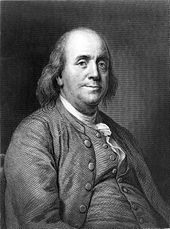
Electricity would remain little more than an intellectual curiosity for millennia until 1600, when the English scientist
Further work was conducted in the 17th and early 18th centuries by

In 1775, Hugh Williamson reported a series of experiments to the Royal Society on the shocks delivered by the
While the early 19th century had seen rapid progress in electrical science, the late 19th century would see the greatest progress in
In 1887,
The first
Solid-state electronics came into its own with the emergence of transistor technology. The first working transistor, a germanium-based point-contact transistor, was invented by John Bardeen and Walter Houser Brattain at Bell Labs in 1947,[29] followed by the bipolar junction transistor in 1948.[30]
Concepts
Electric charge
The presence of charge gives rise to an electrostatic force: charges exert a force on each other, an effect that was known, though not understood, in antiquity.[23]: 457 A lightweight ball suspended by a fine thread can be charged by touching it with a glass rod that has itself been charged by rubbing with a cloth. If a similar ball is charged by the same glass rod, it is found to repel the first: the charge acts to force the two balls apart. Two balls that are charged with a rubbed amber rod also repel each other. However, if one ball is charged by the glass rod, and the other by an amber rod, the two balls are found to attract each other. These phenomena were investigated in the late eighteenth century by Charles-Augustin de Coulomb, who deduced that charge manifests itself in two opposing forms. This discovery led to the well-known axiom: like-charged objects repel and opposite-charged objects attract.[23]
The force acts on the charged particles themselves, hence charge has a tendency to spread itself as evenly as possible over a conducting surface. The magnitude of the electromagnetic force, whether attractive or repulsive, is given by
Charge originates from certain types of
The charge on electrons and protons is opposite in sign, hence an amount of charge may be expressed as being either negative or positive. By convention, the charge carried by electrons is deemed negative, and that by protons positive, a custom that originated with the work of Benjamin Franklin.[37] The amount of charge is usually given the symbol Q and expressed in coulombs;[38] each electron carries the same charge of approximately −1.6022×10−19 coulomb. The proton has a charge that is equal and opposite, and thus +1.6022×10−19 coulomb. Charge is possessed not just by matter, but also by antimatter, each antiparticle bearing an equal and opposite charge to its corresponding particle.[39]
Charge can be measured by a number of means, an early instrument being the
Electric current
The movement of electric charge is known as an
By historical convention, a positive current is defined as having the same direction of flow as any positive charge it contains, or to flow from the most positive part of a circuit to the most negative part. Current defined in this manner is called
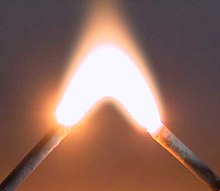
The process by which electric current passes through a material is termed
Current causes several observable effects, which historically were the means of recognising its presence. That water could be decomposed by the current from a voltaic pile was discovered by
In engineering or household applications, current is often described as being either
Electric field
The concept of the electric field was introduced by Michael Faraday. An electric field is created by a charged body in the space that surrounds it, and results in a force exerted on any other charges placed within the field. The electric field acts between two charges in a similar manner to the way that the gravitational field acts between two masses, and like it, extends towards infinity and shows an inverse square relationship with distance.[34] However, there is an important difference. Gravity always acts in attraction, drawing two masses together, while the electric field can result in either attraction or repulsion. Since large bodies such as planets generally carry no net charge, the electric field at a distance is usually zero. Thus gravity is the dominant force at distance in the universe, despite being much weaker.[35]
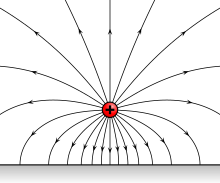
An electric field generally varies in space,
The study of electric fields created by stationary charges is called electrostatics. The field may be visualised by a set of imaginary lines whose direction at any point is the same as that of the field. This concept was introduced by Faraday,[45] whose term 'lines of force' still sometimes sees use. The field lines are the paths that a point positive charge would seek to make as it was forced to move within the field; they are however an imaginary concept with no physical existence, and the field permeates all the intervening space between the lines.[45] Field lines emanating from stationary charges have several key properties: first, that they originate at positive charges and terminate at negative charges; second, that they must enter any good conductor at right angles, and third, that they may never cross nor close in on themselves.[23]: 479
A hollow conducting body carries all its charge on its outer surface. The field is therefore 0 at all places inside the body.[32]: 88 This is the operating principal of the Faraday cage, a conducting metal shell which isolates its interior from outside electrical effects.
The principles of electrostatics are important when designing items of high-voltage equipment. There is a finite limit to the electric field strength that may be withstood by any medium. Beyond this point, electrical breakdown occurs and an electric arc causes flashover between the charged parts. Air, for example, tends to arc across small gaps at electric field strengths which exceed 30 kV per centimetre. Over larger gaps, its breakdown strength is weaker, perhaps 1 kV per centimetre.[46]: 2 The most visible natural occurrence of this is lightning, caused when charge becomes separated in the clouds by rising columns of air, and raises the electric field in the air to greater than it can withstand. The voltage of a large lightning cloud may be as high as 100 MV and have discharge energies as great as 250 kWh.[46]: 201–02
The field strength is greatly affected by nearby conducting objects, and it is particularly intense when it is forced to curve around sharply pointed objects. This principle is exploited in the
Electric potential
The concept of electric potential is closely linked to that of the electric field. A small charge placed within an electric field experiences a force, and to have brought that charge to that point against the force requires
For practical purposes, it is useful to define a common reference point to which potentials may be expressed and compared. While this could be at infinity, a much more useful reference is the Earth itself, which is assumed to be at the same potential everywhere. This reference point naturally takes the name earth or ground. Earth is assumed to be an infinite source of equal amounts of positive and negative charge, and is therefore electrically uncharged—and unchargeable.[48]
Electric potential is a scalar quantity, that is, it has only magnitude and not direction. It may be viewed as analogous to height: just as a released object will fall through a difference in heights caused by a gravitational field, so a charge will 'fall' across the voltage caused by an electric field.[49] As relief maps show contour lines marking points of equal height, a set of lines marking points of equal potential (known as equipotentials) may be drawn around an electrostatically charged object. The equipotentials cross all lines of force at right angles. They must also lie parallel to a conductor's surface, since otherwise there would be a force along the surface of the conductor that would move the charge carriers to even the potential across the surface.
The electric field was formally defined as the force exerted per unit charge, but the concept of potential allows for a more useful and equivalent definition: the electric field is the local gradient of the electric potential. Usually expressed in volts per metre, the vector direction of the field is the line of greatest slope of potential, and where the equipotentials lie closest together.[32]: 60
Electromagnets
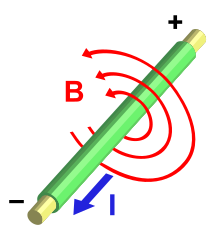
Ørsted's discovery in 1821 that a magnetic field existed around all sides of a wire carrying an electric current indicated that there was a direct relationship between electricity and magnetism. Moreover, the interaction seemed different from gravitational and electrostatic forces, the two forces of nature then known. The force on the compass needle did not direct it to or away from the current-carrying wire, but acted at right angles to it.[21]: 370 Ørsted's words were that "the electric conflict acts in a revolving manner." The force also depended on the direction of the current, for if the flow was reversed, then the force did too.[50]
Ørsted did not fully understand his discovery, but he observed the effect was reciprocal: a current exerts a force on a magnet, and a magnetic field exerts a force on a current. The phenomenon was further investigated by Ampère, who discovered that two parallel current-carrying wires exerted a force upon each other: two wires conducting currents in the same direction are attracted to each other, while wires containing currents in opposite directions are forced apart.[51] The interaction is mediated by the magnetic field each current produces and forms the basis for the international definition of the ampere.[51]
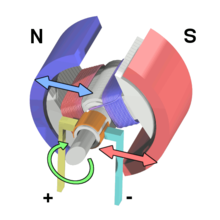
This relationship between magnetic fields and currents is extremely important, for it led to Michael Faraday's invention of the
Experimentation by Faraday in 1831 revealed that a wire moving perpendicular to a magnetic field developed a potential difference between its ends. Further analysis of this process, known as
Electric circuits
An electric circuit is an interconnection of electric components such that electric charge is made to flow along a closed path (a circuit), usually to perform some useful task.[54]
The components in an electric circuit can take many forms, which can include elements such as
The
The capacitor is a development of the Leyden jar and is a device that can store charge, and thereby storing electrical energy in the resulting field. It consists of two conducting plates separated by a thin insulating dielectric layer; in practice, thin metal foils are coiled together, increasing the surface area per unit volume and therefore the capacitance. The unit of capacitance is the farad, named after Michael Faraday, and given the symbol F: one farad is the capacitance that develops a potential difference of one volt when it stores a charge of one coulomb. A capacitor connected to a voltage supply initially causes a current as it accumulates charge; this current will however decay in time as the capacitor fills, eventually falling to zero. A capacitor will therefore not permit a steady state current, but instead blocks it.[55]: 216–20
The inductor is a conductor, usually a coil of wire, that stores energy in a magnetic field in response to the current through it. When the current changes, the magnetic field does too, inducing a voltage between the ends of the conductor. The induced voltage is proportional to the time rate of change of the current. The constant of proportionality is termed the inductance. The unit of inductance is the henry, named after Joseph Henry, a contemporary of Faraday. One henry is the inductance that will induce a potential difference of one volt if the current through it changes at a rate of one ampere per second. The inductor's behaviour is in some regards converse to that of the capacitor: it will freely allow an unchanging current, but opposes a rapidly changing one.[55]: 226–29
Electric power
Electric power is the rate at which
.Electric power, like
where
- Q is electric charge in coulombs
- t is time in seconds
- I is electric current in amperes
- V is electric potential or voltage in volts
Electric power is generally supplied to businesses and homes by the
Electronics
Electronics deals with
Today, most electronic devices use
Electromagnetic wave
Faraday's and Ampère's work showed that a time-varying magnetic field created an electric field, and a time-varying electric field created a magnetic field. Thus, when either field is changing in time, a field of the other is always induced.
The work of many researchers enabled the use of electronics to convert signals into high frequency oscillating currents and, via suitably shaped conductors, electricity permits the transmission and reception of these signals via radio waves over very long distances.[60]
Production, storage and uses
Generation and transmission
In the 6th century BC the Greek philosopher
Electrical power is usually generated by electro-mechanical

Demand for electricity grows with great rapidity as a nation modernises and its economy develops.[64] The United States showed a 12% increase in demand during each year of the first three decades of the twentieth century,[65] a rate of growth that is now being experienced by emerging economies such as those of India or China.[66][67]
Transmission and storage
The invention in the late nineteenth century of the
Normally, demand of electricity must match the supply, as storage of electricity is difficult.[69] A certain amount of generation must always be held in reserve to cushion an electrical grid against inevitable disturbances and losses.[71] With increasing levels of variable renewable energy (wind and solar energy) in the grid, it has become more challenging to match supply and demand. Storage plays an increasing role in bridging that gap. There are four types of energy storage technologies, each in varying states of technology readiness: batteries (electrochemical storage), chemical storage such as hydrogen, thermal or mechanical (such as pumped hydropower).[72]
Applications
Electricity is a very convenient way to transfer energy, and it has been adapted to a huge, and growing, number of uses.[73] The invention of a practical incandescent light bulb in the 1870s led to lighting becoming one of the first publicly available applications of electrical power. Although electrification brought with it its own dangers, replacing the naked flames of gas lighting greatly reduced fire hazards within homes and factories.[74] Public utilities were set up in many cities targeting the burgeoning market for electrical lighting. In the late 20th century and in modern times, the trend has started to flow in the direction of deregulation in the electrical power sector.[75]
The resistive
The effects of electromagnetism are most visibly employed in the
Electricity is used within
Electronic devices make use of the transistor, perhaps one of the most important inventions of the twentieth century,[85] and a fundamental building block of all modern circuitry. A modern integrated circuit may contain many billions of miniaturised transistors in a region only a few centimetres square.[86]
Electricity and the natural world
Physiological effects
A voltage applied to a human body causes an electric current through the tissues, and although the relationship is non-linear, the greater the voltage, the greater the current.[87] The threshold for perception varies with the supply frequency and with the path of the current, but is about 0.1 mA to 1 mA for mains-frequency electricity, though a current as low as a microamp can be detected as an electrovibration effect under certain conditions.[88] If the current is sufficiently high, it will cause muscle contraction, fibrillation of the heart, and tissue burns.[87] The lack of any visible sign that a conductor is electrified makes electricity a particular hazard. The pain caused by an electric shock can be intense, leading electricity at times to be employed as a method of torture.[89] Death caused by an electric shock—electrocution—is still used for judicial execution in some US states, though its use had become very rare by the end of the 20th century.[90]
Electrical phenomena in nature
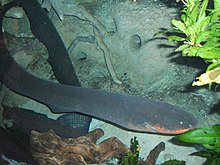
Electricity is not a human invention, and may be observed in several forms in nature, notably
Some organisms, such as
Cultural perception
It is said that in the 1850s, British politician
In the 19th and early 20th century, electricity was not part of the everyday life of many people, even in the industrialised Western world. The popular culture of the time accordingly often depicted it as a mysterious, quasi-magical force that can slay the living, revive the dead or otherwise bend the laws of nature.[100]: 69 This attitude began with the 1771 experiments of Luigi Galvani in which the legs of dead frogs were shown to twitch on application of animal electricity. "Revitalization" or resuscitation of apparently dead or drowned persons was reported in the medical literature shortly after Galvani's work. These results were known to Mary Shelley when she authored Frankenstein (1819), although she does not name the method of revitalization of the monster. The revitalization of monsters with electricity later became a stock theme in horror films.
As the public familiarity with electricity as the lifeblood of the
With electricity ceasing to be a novelty and becoming a necessity of everyday life in the later half of the 20th century, it required particular attention by popular culture only when it stops flowing,[100]: 71 an event that usually signals disaster.[100]: 71 The people who keep it flowing, such as the nameless hero of Jimmy Webb's song "Wichita Lineman" (1968),[100]: 71 are still often cast as heroic, wizard-like figures.[100]: 71
See also
- Ampère's circuital law, connects the direction of an electric current and its associated magnetic currents.
- Electric potential energy, the potential energy of a system of charges
- Electricity market, the sale of electrical energy
- Etymology of electricity, the origin of the word electricity and its current different usages
- Hydraulic analogy, an analogy between the flow of water and electric current
- Bioelectricity– Electric current produced in living cells
Notes
- ^ Jones, D.A. (1991), "Electrical engineering: the backbone of society", IEE Proceedings A – Science, Measurement and Technology, 138 (1): 1–10,
- JSTOR 1311732
- ^ a b c
Bullock, Theodore H. (2005), Electroreception, Springer, pp. 5–7, ISBN 978-0-387-23192-1
- ^ a b
Morris, Simon C. (2003), Life's Solution: Inevitable Humans in a Lonely Universe, Cambridge University Press, pp. 182–85, ISBN 0-521-82704-3
- ^ a b
Stewart, Joseph (2001), Intermediate Electromagnetic Theory, World Scientific, p. 50, ISBN 981-02-4471-1
- ^
Simpson, Brian (2003), Electrical Stimulation and the Relief of Pain, Elsevier Health Sciences, pp. 6–7, ISBN 0-444-51258-6
- ^ Diogenes Laertius, R.D. Hicks (ed.), "Lives of Eminent Philosophers, Book 1 Chapter 1 [24]", Perseus Digital Library, Tufts University, archived from the original on 30 July 2022, retrieved 5 February 2017,
Aristotle and Hippias affirm that, arguing from the magnet and from amber, he attributed a soul or life even to inanimate objects.
- ^ Aristotle, Daniel C. Stevenson (ed.), "De Animus (On the Soul) Book 1 Part 2 (B4 verso)", The Internet Classics Archive, translated by J.A. Smith, archived from the original on 26 February 2017, retrieved 5 February 2017,
Thales, too, to judge from what is recorded about him, seems to have held soul to be a motive force, since he said that the magnet has a soul in it because it moves the iron.
- ^ Frood, Arran (27 February 2003), Riddle of 'Baghdad's batteries', BBC, archived from the original on 3 September 2017, retrieved 16 February 2008
- ^
Baigrie, Brian (2007), Electricity and Magnetism: A Historical Perspective, Greenwood Press, pp. 7–8, ISBN 978-0-313-33358-3
- ^
Chalmers, Gordon (1937), "The Lodestone and the Understanding of Matter in Seventeenth Century England", Philosophy of Science, 4 (1): 75–95, S2CID 121067746
- ^ S2CID 34246664
- ^
Srodes, James (2002), Franklin: The Essential Founding Father, Regnery Publishing, pp. 92–94, ISBN 0-89526-163-4. It is uncertain if Franklin personally carried out this experiment, but it is popularly attributed to him.
- ISBN 0-486-25237-X
- ^ Riskin, Jessica (1998), Poor Richard's Leyden Jar: Electricity and economy in Franklinist France (PDF), p. 327, archived (PDF) from the original on 12 May 2014, retrieved 11 May 2014
- from the original on 30 July 2022, retrieved 16 July 2022
- ^ Edwards, Paul (10 November 2021), A Correction to the Record of Early Electrophysiology Research on the 250th Anniversary of a Historic Expedition to Île de Ré, HAL open-access archive
- ^ Hunter, John (1775), "An account of the Gymnotus electricus", Philosophical Transactions of the Royal Society of London (65): 395–407
- ^ S2CID 39105914
- ^ a b c
Kirby, Richard S. (1990), Engineering in History, Courier Dover Publications, pp. 331–33, ISBN 0-486-26412-2
- ^ a b c
Berkson, William (1974), Fields of Force: The Development of a World View from Faraday to Einstein, Routledge, ISBN 0-7100-7626-6
- ISBN 978-0-7484-0765-1
- ^ a b c d e f g h i j
Sears, Francis; et al. (1982), University Physics, Sixth Edition, Addison Wesley, ISBN 0-201-07199-1
- from the original on 11 June 2020, retrieved 25 August 2019
- ^ "The Nobel Prize in Physics 1921", Nobel Foundation, archived from the original on 17 October 2008, retrieved 16 March 2013
- ^ "Solid state", The Free Dictionary, archived from the original on 21 July 2018
- ^ Blakemore, John Sydney (1985), Solid state physics, Cambridge University Press, pp. 1–3
- ISBN 0-07-250503-6
- ^ "1947: Invention of the Point-Contact Transistor", Computer History Museum, archived from the original on 30 September 2021, retrieved 10 August 2019
- ^ "1948: Conception of the Junction Transistor", The Silicon Engine, Computer History Museum, archived from the original on 30 July 2020, retrieved 8 October 2019
- ^ Coulomb, Charles-Augustin de (1785), Histoire de l'Academie Royal des Sciences, Paris,
The repulsive force between two small spheres charged with the same type of electricity is inversely proportional to the square of the distance between the centres of the two spheres.
- ^ a b c d e f g
Duffin, W.J. (1980), Electricity and Magnetism, 3rd edition, McGraw-Hill, ISBN 0-07-084111-X
- ^
National Research Council (1998), Physics Through the 1990s, National Academies Press, pp. 215–16, ISBN 0-309-03576-7
- ^ a b
Umashankar, Korada (1989), Introduction to Engineering Electromagnetic Fields, World Scientific, pp. 77–79, ISBN 9971-5-0921-0
- ^ a b
Hawking, Stephen (1988), A Brief History of Time, Bantam Press, p. 77, ISBN 0-553-17521-1
- ^
Trefil, James (2003), The Nature of Science: An A–Z Guide to the Laws and Principles Governing Our Universe, Houghton Mifflin Books, p. 74, ISBN 0-618-31938-7
- ^
Shectman, Jonathan (2003), Groundbreaking Scientific Experiments, Inventions, and Discoveries of the 18th Century, Greenwood Press, pp. 87–91, ISBN 0-313-32015-2
- ^ Sewell, Tyson (1902), The Elements of Electrical Engineering, Lockwood, p. 18. The Q originally stood for 'quantity of electricity', the term 'electricity' now more commonly expressed as 'charge'.
- ^
Close, Frank (2007), The New Cosmic Onion: Quarks and the Nature of the Universe, CRC Press, p. 51, ISBN 978-1-58488-798-0
- ^ Al-Khalili, Jim, "Shock and Awe: The Story of Electricity", BBC Horizon
- ^ Ward, Robert (1960), Introduction to Electrical Engineering, Prentice-Hall, p. 18
- ^
Solymar, L. (1984), Lectures on electromagnetic theory, Oxford University Press, p. 140, ISBN 0-19-856169-5
- ^ "Lab Note #105 EMI Reduction – Unsuppressed vs. Suppressed", Arc Suppression Technologies, April 2011, archived from the original on 5 March 2016, retrieved 7 March 2012
- ^ a b c
Bird, John (2007), Electrical and Electronic Principles and Technology, 3rd edition, Newnes, ISBN 978-1-4175-0543-2
- ^ a b
Morely & Hughes (1970), Principles of Electricity, Fifth edition, Longman, p. 73, ISBN 0-582-42629-4
- ^ a b
Naidu, M.S.; Kamataru, V. (1982), High Voltage Engineering, Tata McGraw-Hill, ISBN 0-07-451786-4
- ISBN 978-0-8018-6909-9
- ^
Serway, Raymond A. (2006), Serway's College Physics, Thomson Brooks, p. 500, ISBN 0-534-99724-4
- from the original on 16 February 2008, retrieved 9 December 2007
- ^
Thompson, Silvanus P. (2004), Michael Faraday: His Life and Work, Elibron Classics, p. 79, ISBN 1-4212-7387-X
- ^ a b Morely & Hughes, Principles of Electricity, Fifth edition, pp. 92–93
- ^ a b Institution of Engineering and Technology, Michael Faraday: Biography, archived from the original on 3 July 2007, retrieved 9 December 2007
- ISBN 978-0-85762-762-9
- ISBN 978-1-951693-21-3
- ^ ISBN 978-0-07-330115-0
- ^ Smith, Clare (2001), Environmental Physics
- ^ ISBN 978-0-521-80926-9
- ISBN 978-0-19-105746-5
- ISBN 978-0-08-050681-4
- ISBN 9781107605909
- ^ a b
Dell, Ronald; Rand, David (2001), "Understanding Batteries", NASA Sti/Recon Technical Report N, 86, Royal Society of Chemistry: 2–4, ISBN 0-85404-605-4
- ^
McLaren, Peter G. (1984), Elementary Electric Power and Machines, Ellis Horwood, pp. 182–83, ISBN 0-85312-269-5
- ^ "How electricity is generated", U.S. Energy Information Administration (EIA), 9 November 2022, retrieved 19 February 2023
- ISBN 978-1-61039-749-0, archivedfrom the original on 7 November 2021, retrieved 7 November 2021
- ^ Edison Electric Institute, History of the U.S. Electric Power Industry, 1882–1991, archived from the original on 6 December 2010, retrieved 8 December 2007
- ^ Carbon Sequestration Leadership Forum, An Energy Summary of India, archived from the original on 5 December 2007, retrieved 8 December 2007
- ^ IndexMundi, China Electricity – consumption, archived from the original on 17 June 2019, retrieved 8 December 2007
- ISBN 978-0-429-93916-7, archivedfrom the original on 6 June 2020
- ^ a b
Patterson, Walter C. (1999), Transforming Electricity: The Coming Generation of Change, Earthscan, pp. 44–48, ISBN 1-85383-341-X
- ^ Edison Electric Institute, History of the Electric Power Industry, archived from the original on 13 November 2007, retrieved 8 December 2007
- ISSN 0196-8904
- ISBN 978-0-578-29263-2
- ^ Wald, Matthew (21 March 1990), "Growing Use of Electricity Raises Questions on Supply", New York Times, archived from the original on 8 January 2008, retrieved 9 December 2007
- ^ d'Alroy Jones, Peter, The Consumer Society: A History of American Capitalism, Penguin Books, p. 211
- ^ "The Bumpy Road to Energy Deregulation", EnPowered, 28 March 2016, archived from the original on 7 April 2017, retrieved 29 May 2017
- ^
ReVelle, Charles and Penelope (1992), The Global Environment: Securing a Sustainable Future, Jones & Bartlett, p. 298, ISBN 0-86720-321-8
- ^ Danish Ministry of Environment and Energy, "F.2 The Heat Supply Act", Denmark's Second National Communication on Climate Change, archived from the original on 8 January 2008, retrieved 9 December 2007
- ^
Brown, Charles E. (2002), Power resources, Springer, ISBN 3-540-42634-5
- ^ Hojjati, B.; Battles, S., The Growth in Electricity Demand in U.S. Households, 1981–2001: Implications for Carbon Emissions (PDF), archived from the original (PDF) on 16 February 2008, retrieved 9 December 2007
- ISSN 0013-0613, retrieved 13 March 2023
- ISBN 9781009157926
- S2CID 257067540
- ^ "Public Transportation", Alternative Energy News, 10 March 2010, archived from the original on 4 December 2010, retrieved 2 December 2010
- S2CID 110320981
- ^
Herrick, Dennis F. (2003), Media Management in the Age of Giants: Business Dynamics of Journalism, Blackwell Publishing, ISBN 0-8138-1699-8
- ^ Das, Saswato R. (15 December 2007), "The tiny, mighty transistor", Los Angeles Times, archived from the original on 11 October 2008, retrieved 12 January 2008
- ^ a b
Tleis, Nasser (2008), Power System Modelling and Fault Analysis, Elsevier, pp. 552–54, ISBN 978-0-7506-8074-5
- ^
Grimnes, Sverre (2000), Bioimpedance and Bioelectricity Basic, Academic Press, pp. 301–09, ISBN 0-12-303260-1
- ^
Lipschultz, J.H.; Hilt, M.L.J.H. (2002), Crime and Local Television News, Lawrence Erlbaum Associates, p. 95, ISBN 0-8058-3620-9
- S2CID 225595301
- ^
ISBN 3-540-00241-3
- ^ a b
Lima-de-Faria, José; Buerger, Martin J. (1990), "Historical Atlas of Crystallography", Zeitschrift für Kristallographie, 209 (12), Springer: 67, ISBN 0-7923-0649-X
- ^
Ivancevic, Vladimir & Tijana (2005), Natural Biodynamics, World Scientific, p. 602, ISBN 981-256-534-5
- ^ a b
Kandel, E.; Schwartz, J.; Jessell, T. (2000), Principles of Neural Science, McGraw-Hill Professional, pp. 27–28, ISBN 0-8385-7701-6
- ISBN 978-0-12-369411-9
- ^ Jackson, Mark (4 November 2013), Theoretical physics – like sex, but with no need to experiment, The Conversation, archived from the original on 4 April 2014, retrieved 26 March 2014
- S2CID 4420175
- ^ Heuer, Rolf (February 2011), "One Day, Sir, You May Tax It", CERN Bulletin (7–08/2011)
- ^ Mikkelson, David (25 November 2000), "Michael Faraday 'Tax' Quote", Snopes
- ^ ISBN 0-313-31822-0
References
- Benjamin, Park (1898), A history of electricity: (The intellectual rise in electricity) from antiquity to the days of Benjamin Franklin, New York: J. Wiley & Sons
- Hammond, Percy (1981), "Electromagnetism for Engineers", Nature, 168 (4262), Pergamon: 4–5, S2CID 27576009
- Morely, A.; Hughes, E. (1994), Principles of Electricity (5th ed.), Longman, ISBN 0-582-22874-3
- Nahvi, Mahmood; Joseph, Edminister (1965), Electric Circuits, McGraw-Hill, ISBN 978-0071422413
- Naidu, M.S.; Kamataru, V. (1982), High Voltage Engineering, Tata McGraw-Hill, ISBN 0-07-451786-4
- Nilsson, James; Riedel, Susan (2007), Electric Circuits, Prentice Hall, ISBN 978-0-13-198925-2
- Patterson, Walter C. (1999), Transforming Electricity: The Coming Generation of Change, Earthscan, ISBN 1-85383-341-X
External links
- Basic Concepts of Electricity chapter from Lessons In Electric Circuits Vol 1 DC book and series.
- "One-Hundred Years of Electricity", May 1931, Popular Mechanics
- Illustrated view of how an American home's electrical system works
- Socket and plug standards
- Electricity Misconceptions
- Electricity and Magnetism
- Understanding Electricity and Electronics in about 10 Minutes

